| Peñíscola in the past | ||
| I was lucky enough
to find these images recently, please excuse quality of some of the
photos. click on thumbs |
||
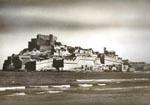 |
Note that there are not as many houses crammed within the Casco as there
are today, not all are painted white as is the fashion today. Before El Cid |
|
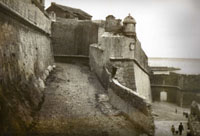 |
Entry to
Casco, now a much refurbished area
|
|
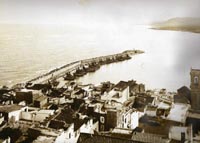 |
This photo would be taken just after the harbour wall was built in the 1920s. Note the boats are still under sail power, with perhaps some help from marine motors. | |
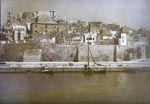 |
The Port mooring before the "Lonja" was built, not a TV aerial in sight. Hard to date, but possibly same time as above, note delapidated state of castle and unpainted houses. | |
 |
Before Lonja again, note absence of buildings at entrance to Casco | |
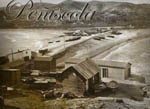 |
This photo is very early twentieth century, has original course of river and before port was built (hillside still intact) | |
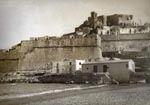 |
Photo taken at same time as above. There are no pointed ramparts on the top wall of the actual castle. See photo below where they have been added for the film | |
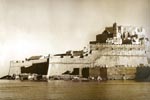 |
The false wall concealing modern buildings. although they are low level. The cannonball damage to the walls wa sustained in 1812 during the Peninsular war by the French, fired from the land during a lengthy siege of the town. | |
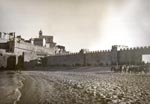 |
False wall again concealing buildings | |
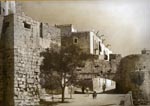 |
Gate up into the Casco, was bricked up in past. | |
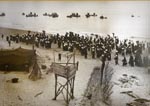 |
Fishing boats disguised as Moors. | |
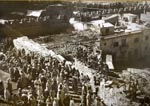 |
The many extras from Peñíscola, employed in the film. This lower section of entrance to Casco has been much altered and improved. | |
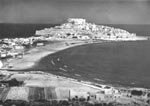 |
Peñíscola probably in the late 1950s. See the building we know as the clinic is already built | |
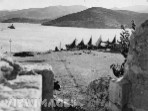 |
Harbour said to be in 1960 | |
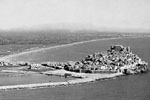 |
Peñíscola said to be in 1956, not much development and nothing along the north beach | |
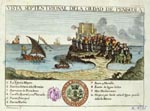 |
Peñíscola, an engraving of 1786 | |
 |
Peñíscola, difficult to date this photo, possibly late 60s early seventies.The hotels Arena Prado, Porto Christo and Apartments Los Delfines are now on this campsite. | |
|
Almost 30
years ago we visited Peñíscola for the day, it was much different to now. The Casco was much the same as it is now, but the port was much different. There were several restaurants at the port edge and the port was much simpler, without the landscaping that was added during the nineties. The area opposite the Hotels Playa and Molino was rough land used as a car park. There was nothing in the way of a road past the Hotel Papa Luna, just a rough track to Benicarlo along the coast. In fact there was not very much at all after the Papa Luna, apart from the Hosteria del Mar, a few isolated small blocks, and a few villas. The "Cami Vell" was the normal route to Benicarlo as the sea often encroached on to the land along the beach. The land near the beach was occupied with many campsites most of them not much better than camping savauge. The oldest large apartment block is what is now called Les Doyes, it was originally called the Ramada and was in place before the Papa Luna Hotel |
||
| Some more facts | ||
|
In
1237,
south
of
Peñíscola, along the coast near the tower Abadum, the battle of
Anisa
took
place.
Between
the
Muslims and Christians,
this was of importance
to
the
re-conquest
of the
Kingdom of Valencia. The castle was started in 1296 and finished in 1304. The town was well known to mariners due the fact that drinking water was found on the peninsula, in 3 "manantiales". The water table in the area is very high and on the south coast near the deserted Guardia Civil cuartel, fresh water bubbles actually up on the beach. The Torre Abadum or Badum was a watch tower to warn of approaching invaders. Las Atalayas means watchtowers, and beacons or bonfires would have been lit to alert the town and surrounding areas. In medieval times Peñíscola had a "Gabela de Sal". This was a state run establishment for harvesting, storing and distribution of salt. The was also a tax to pay on all salt used. The marshy areas between Peñíscola and Benicarlo were used as "salinas" to evaporate the salt water and harvest the salt. The fortress at Peniscola was considered impregnable, was well known as Little Gibraltar. In the peninsular war, a garrison of 1000 men defended the castle. In 1812 the town endured a 14 day siege by the French led by General Suchet, and the fortess was finally betrayed by its commander General Navarro. He would sooner surrender to the French than campaign under British orders. Most of the townsfolk had to leave the fortess under pain of death, and lived in Benicarlo and fincas in the area. 74 pieces of ordinance were captured but sixty Frenchmen were killed. The town was recaptured in 1814 and most of the cannonball damage was caused by the Spanish in the re-taking of Peniscola. Whilst the walls would withstand the cannon attacks the town itself was virtually reduced to ruins including the gothic buildings which had housed the papal staff. The castle was left in poor condition until the making of El Cid.
The title of "City" was
conferred after a visit in 1929 by King Alfonso XIII. The fishing port was
constructed and was finished 1922, a railway line was laid betwen the port
and Mont Cerro. Presumably some sort of steam engine was used to
haul wagons along the line (reminiscent of mining in Britain) or more
likely, horse power was used. |
||
The course of the river was changed in the early 20th century, originally it ran down the street at the back of the Hotels, Playa and Riomar, this street is called Calle Rio. |
||
|
Peñíscola has always been a very insular place in
more ways than one. Most of the residents came from a small nucleus of
around 12 families, and most marriages were within the
Peñíscolano community. They all lived within the "casco"
and earned their living as fishermen. If you study the traditional fishing
families, they all seem to have a similar shape, stocky and small.
The population has stayed at around 3,000 since 1900, only in recent years
has it risen to the 6,000 of today. The fishing industry would not have expanded until the advent of common motorised transport and communications. With the later generations of marine engines, the boats started going to the "Columbres" archipelago, some 40 miles away. Most of the day is spent in travelling to and from these fishing grounds, with enough time for one trawl and then back to port. The money raised for the catch is split 3 ways, one third to the owner of the boat, one third for fuel and maintenance, the crew split the rest between them. Traditionally, in the "lonja", the auction currency was "duros" and the language was the peñíscolano dialect of valenciano. Some of these families are now wealthy people, the small pieces of land they owned and used as warehouses were situated in what has become the main area of Peñíscola. This of course became very desirable real estate in later years. |
||
|
Benicarlo was a volume wine producer until
the outbreak of Phyloxera spread to here towards the end of the 19th
century. The best wine was known as "Carlo" and the region had a
production roughly equal to that of St Chinian in the Languedoc, France.
The wine however, did not have a good reputation, but it was produced in
quantity and was cheap. In 1890, it exported 17million litres of
wine. Most of the wine was exported to Bordeaux and used to strengthen and blend French wines. (remember, Appellation Controlle did not commence until 1935) The "mush" from the wine was distilled as brandy in Vinaroz, and again this went to Cadiz and Portugal to fortify sherry and port. I have seen a figure of 1000 butts of brandy, annually exported. (a butt or pipe being approx 480 litres) This must have made Benicarlo a prosperous place. The area never recovered after the outbreak but today the "margens" are still visible on the hills around here (dry stone walls to protect from wind erosion) |
||
| The flat land in the area was put to vegetable cultivation, especially the artichoke and orange. | ||
| A few British property owners started emerging in Peñíscola during the early sixties. Sadly none of these people are alive today, but we did meet most of them. | ||
| back to main page | ||